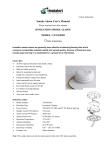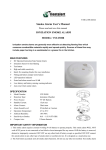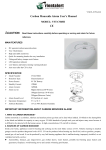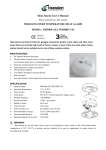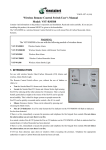Download VST-G386AD GAS ALARM USER`S MANUAL
Transcript
VST-G386AD-N (Natural Gas) VST-G386AD-L (LPG) √ VST-G386AD-M (Man-made Coal Gas) Combustible Gas Alarm User’s Manual Please read and save this manual VST-G386AD GAS ALARM USER’S MANUAL FEATURES AC Operated Combustible Gas Alarm Semiconductor Gas Sensor Resistance Against Cooking Smoke Or Ethanol Steam Wall Mounted Installation Operation Indicator Sensor Fault Indicator Alarm With Sound & Light Indicator Self-test Button SPECIFICATION Model Number: Operating Temperature: Humidity Rating: Electrical Rating: Alarm Power: Detect Gas: Alarm Density: Alarm Output: Reacting/ reset time: VST-G386AD -10 to 50 30%-95% 220V AC 1.5 W Natural Gas or LPG or Man-made Coal Gas (Custom-made and optional) Natural Gas 1~25%LEL LPG 1~25%LEL Man-made Coal Gas 125~750 X 10-6 NO/NC Signal, Pulse Signal, Wireless Transmitting Signal (optional) 20 seconds ℃ ℃ ≦ ; ≦ PRODUCT DESCRIPTION The VST-G386AD Gas Alarm is a safety system for residential use. It is intended to detect leakage of natural gas, LPG and man-made coal gas. It provides an early warning in the case of the existence of any dangerous conditions. INSTALLATION 1. The maximum distance away from the furnace or gas appliances is 1.5 meters. The actual position should be: for detecting natural gas and man-made coal gas (lighter than air), the alarm should be installed within 30 centimeters below the ceiling. for detecting LPG (heavier than air), the alarm should be installed within 30 centimeters above the floor. 2. Fix the alarm to the wall. 3. Turn on the power. The green light goes to the normal working state after flashing for about 120 seconds. 4. Test the alarm to ensure the unit is in operating mode. See section “TEST THE GAS ALARM”. ① ② WARNING: 1. Do not install the alarm toward the furnace smoke or steam. Prevent the alarm from being polluted by smoke and steam. (Cooking smells and other fumes can have a bad influence on gas detection). 2. Do not install the alarm in areas with high humidity like bathrooms and areas near dishwashers or washing machines. 3. Do not install the alarm in areas where air flows freely. 4. Make sure the alarm will not be covered by any obstacles. GAS ALARM OPERATION 1. Detector signals PHENOMENON PROBLEM SOLUTION Green light(Power) goes out The power is off or there is something wrong with the supply power Check the power supply system or the connection of supply power Yellow light(Fault) flashes once a second, and the buzzer alarms every five seconds Sensor problem Turn to the agents or producers Red light(Alarm) is on and the buzzer alarms continuously Gas leaking See Section “ WHAT TO DO WHEN THE ALARM SOUNDS” 2. The alarm won’t work if the power is off. TEST THE GAS ALARM 1. The detector has auto test function when the TEST button is pressed. The RED indicator light (LED) will flash quickly and the alarm will sound. To keep safe operation, users should test the detector every three months. 2. Keep spraying the lighter gas for 2 to 5 seconds at about 1cm above from the Detect Window. If alarm doesn’t sound, please repeat the same steps three times. If it still doesn’t alarm, inform the agents or our company to check and maintain. WARNING: Do not spray the lighter gas from a too close distance or keep spraying for too long. Otherwise this will cause the damage to the sensor. 2. Press the TEST button and the alarm will test itself. The red light will be on, and the buzzer will alarm. 3. The detector doesn’t need to be adjusted. The phase shifting of sensor seldom happens during the sensor life. MAINTENACE 1. Do not paint on the surface of detector. 2. Avoid high heat and humidity. 3. Do not use grindstone or cleaning liquid to rub the surface. Never use detergents or solvents to clean the alarm. Chemicals can permanently damage or temporarily contaminate the sensor. 4. Do not install the detector in or near smoke drain or chimney 5. Vacuum the alarm cover once a month to remove accumulated dust. Use the soft brush attachment of your vacuum cleaner, and unplug the alarm from the electrical outlet before vacuuming. 6. If the gas detector is in error, do not disassemble the unit by yourself, but get advice from professional company or service provider. WHAT TO DO WHEN THE ALARM SOUNDS 1. Open all windows and doors to allow the air flow freely. 2. Check to be sure: ⊙if the gas is leaking ⊙if someone feels sick If the situations above don’t happen, press the TEST button to make the alarm test automatically. If the situation is not improved, the alarm signal will be on again after several minutes. 3. Find out the real reasons of the alarms. 4. Stop using the gas kitchen furnaces if someone feels sick and go to the areas where air flows freely. Inform and wait for the maintenance worker. 5. If you hear the gas alarm sound or suspect that there is a gas leakage. You should open all windows and doors to allow the gas to disperse. If the alarming signal is on because of gas leakage, the following steps should be taken: Open all windows and doors to allow the gas to disperse. To avoid explosion, do not turn on or turn off any electrical switches or appliances. Check and turn off all the gas supply. Do not smoke. Extinguish any naked flames. Do not look for the leaking gas source by fire. Evacuate the premises immediately if unit is alarming. Call emergency service immediately at the place far away from the gas leaking site. Do not re-enter the home until the problem has been corrected and the gas has been dispersed. HOME SAFETY TIPS What you should do… 1. Buy only appliances approved by a nationally recognized testing laboratory. 2. Choose fuel-burning appliances that can be vented to the outdoors, whenever possible. 3. Make sure appliances are installed according to the manufacturer’s instructions and local building codes. Most appliances should be installed by professionals and should be inspected by the proper authority after installation. 4. Have the heating system, vents, chimney and flue inspected and cleaned by a qualified technician every year. 5. Follow the manufacturer’s directions for safe operation of all fuel-burning appliances. 6. Examine vents and chimneys regularly for improper connections, visible rust or stain. 7. Open a window when a fireplace or wood-burning stove is in use, and provide adequate outdoor air for furnace and water heater. 8. Notice problems that could indicate improper appliance operation: Decreasing hot water supply Furnace unable to heat house or runs constantly Soot, especially on appliances Unfamiliar or burning odor Yellow or orange flames What you should not do… 1. Never burn charcoal inside a home, garage, cabin, RV or camper 2. Never install, service, or convert fuel-burning appliances from one type to another without proper knowledge, skills and tools. 3. Never use an oven or clothes dryer for heating. 4. Never operate unvented gas-burning appliances, such as kerosene or natural gas space heaters, in a closed room. 5. Never operated gasoline-powered engines (like vehicles, motorcycles, lawn mowers, and yard equipment or power tools) in confined areas such as garages or basements, even if an outside door or window is open. 6. Never ignore a safety device when it shuts off an appliance. 7. Never ignore gas alarm. IMPORTANT THIS DEVICE IS NOT SUITABLE AS A CARBON MONOXIDE DETECTOR OR SMOKE/ FIRE DETECTOR. THIS DEVICE IS NOT SUITABLE FOR INSTALLATION IN A HAZARDOUS LOCATION. Manufacturer: Xiamen Vs-Top Electronics Co., Ltd. 2nd floor, No.107 Xiaguang Road, Xinyang Industrial District, Haicang ,Xiamen, China. Tel: 0086-592-6017700 Fax: 0086-592-6017711 E-mail: [email protected] Website: www.orientalert.com






